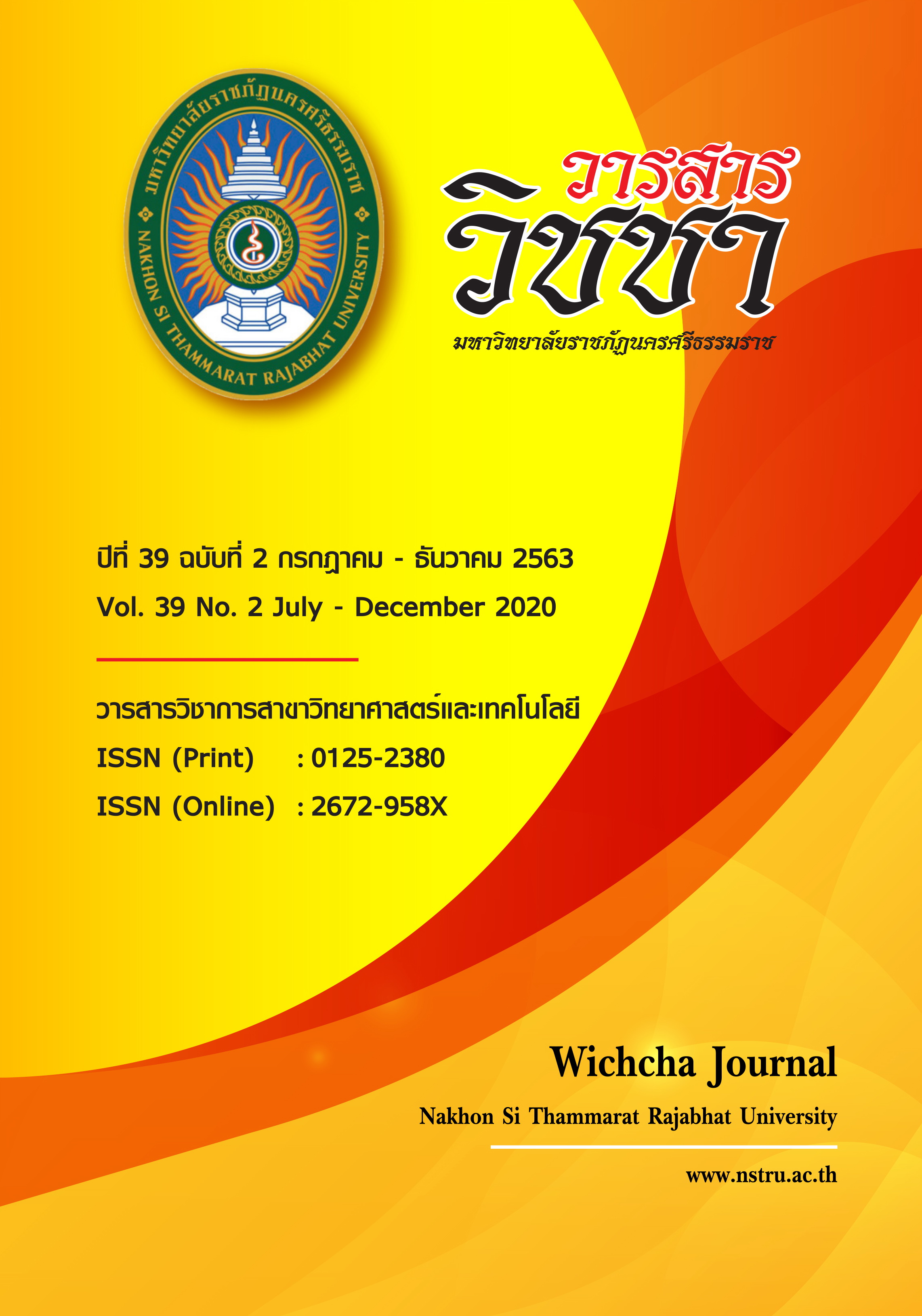Relationship between Temperature, Relative Humidity and Seasonal Variation on Pollen Germination and Pollen Viability in ‘Nam Hom’ Coconut ความสัมพันธ์ระหว่างอุณหภูมิ ความชื้นสัมพัทธ์ และการเปลี่ยนแปลงฤดูกาล ต่อความงอกและความมีชีวิตของละอองเกสรมะพร้าวน้ำหอม
Main Article Content
Abstract
The causes of less fruit set in ‘Nam Hom’ coconuts in dry season are still unknown. Unsuitable temperature and relative humidity at flowering stage might be the factor relating to the less fruit set in ‘Nam Hom’ coconuts. Thus, the objective of the research was to study the relationships between temperature, relative humidity and seasonal variation on pollen germination and pollen viability in ‘Nam Hom’ coconuts. The study was conducted at coconut orchards in Damnoen Saduak district, Ratchaburi province. The results indicated that the relationships between temperature and annual relative humidity with the percentage of pollen germination and the percentage of pollen viability in ‘Nam Hom’ coconuts were not found during the study (p > 0.05). The average temperature in rainy season, winter and summer were 28, 26.16, and 28.84°C respectively. The average relative humidity in rainy season, winter and summer were 87.24, 81 and 83.70%, respectively. The percentage of pollen viability in rainy season, winter and summer were 97.74, 95.11 and 94.57%. The percentage of pollen germination in rainy season, winter and summer were between 47.84, 37.15 and 43.96%, respectively. Although the percentage of pollen germination in rainy season showed the highest trend followed by summer and winter but there was no significant difference (p > 0.05). As the percentage of pollen germination in each month were considered, the percentage of pollen germination in September was the highest percentage (67.73%), whereas those in May and June were the lowest (11.58 and 18.26%, respectively) (p < 0.05). The results from this study would be used for ‘Nam Hom’ coconut orchard management of the farmer to get the suitable environment and solve the problems of less coconut fruit set.
Article Details
เนื้อหาและข้อมูลในบทความที่ลงตีพิมพ์ในวารสารวิชชา มหาวิทยาลัยราชภัฏนครศรีธรรมราช ถือเป็นข้อคิดเห็นและความรับผิดชอบของผู้เขียนบทความโดยตรง ซึ่งกองบรรณาธิการวารสารไม่จำเป็นต้องเห็นด้วยหรือร่วมรับผิดชอบใด ๆ
บทความ ข้อมูล เนื้อหา รูปภาพ ฯลฯ ที่ได้รับการตีพิมพ์ในวารสารวิชชา มหาวิทยาลัยราชภัฏนครศรีธรรมราช ถือเป็นลิขสิทธ์ของวารสารวิชชา มหาวิทยาลัยราชภัฏนครศรีธรรมราช หากบุคคลหรือหน่วยงานใดต้องการนำข้อมูลทั้งหมดหรือส่วนหนึ่งส่วนใดไปเผยแพร่ต่อหรือเพื่อการกระทำการใด ๆ จะต้องได้รับอนุญาตเป็นลายลักษณ์อักษรจากวารสารวิชชา มหาวิทยาลัยราชภัฏนครศรีธรรมราชก่อนเท่านั้น
The content and information in the article published in Wichcha journal Nakhon Si Thammarat Rajabhat University, It is the opinion and responsibility of the author of the article. The editorial journals do not need to agree. Or share any responsibility.
References
กฤษณา กฤษณพุก วชิรญา อิ่มสบาย ภาสันต์ ศารทูลทัต ปิยะณัฎฐ์ ผกามาศ ศุภธิดา อับดุลลาการ์ซิม เกรียงศักดิ์ ไทยพงษ์ ราตรี บุญเรืองรอด อุไรวรรณ นิลเพ็ชร วันชาติ นิติพันธ์ และษราวดี ไทยพงษ์. (2555). การสำรวจข้อมูลเบื้องต้นในการผลิตและปัจจัยที่เกี่ยวข้องของมะพร้าวอ่อนเพื่อส่งออก. กรุงเทพฯ: สำนักงานคณะกรรมการส่งเสริมวิทยาศาสตร์ วิจัยและนวัตกรรม.
เพ็ญนภา ศิริสลุง ปิยะพงษ์ สอนแก้ว และวรภัทร ลัคนทินวงศ์. (2561). ความงอกของละอองเกสรตัวผู้ของมะพร้าวสายพันธุ์ต้นเตี้ยผลสีเขียว 3 พันธุ์ในฤดูต่าง ๆ. วารสารวิทยาศาสตร์เกษตร, 49(1)(พิเศษ), 430-433.
ภูมิ ทองเนื้อห้า. (2559). อิทธิพลของอุณหภูมิต่อความมีชีวิต และความงอกของละอองเกสรมะพร้าวน้ำหอม. วิทยานิพนธ์วิทยาศาสตรมหาบัณฑิต. มหาวิทยาลัยเกษตรศาสตร์. กรุงเทพฯ.
สมพร มณีประสพสุข. (2549). มะพร้าวน้ำหอม การปลูกและการจัดการ. เคหการเกษตร, 30(9), 233-236.
สำนักเศรษฐกิจการเกษตร. (2554). สถิติการค้าสินค้าเกษตรไทยกับต่างประเทศ. กรุงเทพฯ: ศูนย์สารสนเทศการเกษตร สำนักงานเศรษฐกิจการเกษตร. กระทรวงเกษตรและสหกรณ์.
สุพรพรรณ ศรีมาศ กฤษณี เอี่ยมจัด สิริกุล วะสี และเกรียงศักดิ์ ไทยพงษ์. (2557). ผลของฤดูกาลต่อความมีชีวิตและความงอกของละอองเกสรมะละกอ. วารสารแก่นเกษตร, 42(3)(พิเศษ), 174-179.
Brewbaker, J.L. and Kwack, B.H. (1963). The essential role of calcium ion in pollen germination and pollen tube growth. American Journal of Botany, 50(9), 859-865.
Chan, E. and Elevitch, C.R. (2006). Cocos nucifera (coconut), ver. 2.1. In Elevitch, C.R. (Ed.). Species Profiles for Pacific Island Agroforestry. Permanent Agriculture Resources (PAR), Holualoa, Hawaii. Retrieved 1 February 2013, from: http://www.traditionaltree.org.html.
Cross, R.H., Mckay, S.A.B., McHughen, A.G. and Bonham-Smith, P.C. (2003). Heat stress effects on reproduction and seed set in Linum usitatissimum L. Plant Cell and Environment, 26(7), 1013-1020.
Kakani, V.G., Prasad, P.V.V., Craufurd, P.Q and Wheeler, T.R. (2002). Response of in vitro pollen germination and pollen tube growth of groundnut (Arachis hypogaea L.) genotypes to temperature. Plant Cell and Environment, 25(12), 1651-1661.
Kozai, N., Beppu, K., Mochioka, R., Boonprakob, U., Subhadrabandhu, S. and Kataoka, I. (2004). Adverse effects of high temperature on the development of reproductive organs in ‘Hakuho’ peach trees. Journal of Horticultural Science and Biotechnology, 79(4), 533-537.
Mariken, K., Anders, N. and Nils, C.S. (2011). Potential Effects of Climate Change on Crop Pollination. Rome: Food and Agriculture Organization of the United Nations, F.A.O.
Morrison, M.J. and Stewart, D.W. (2002). Heat stress during flowering in summer Brassica. Crop Science, 42(3), 797-803.
Prasad, S.V. and Djanaguiraman, M. (2011). Effect of high temperature stress on pollen viability: role of reactive oxygen species and phospholipids. Department of Agronomy, Kansas State University, Manhattan. Retrieved 1 February 2013, from: http://a-cs.Confex.com/crops/2011am/webprogram/Paper66445.html.
Ranasinghe, C.S., Waidyarathna, K.P., Pradeep, A.P.C. and Meneripitiya, M.S.K. (2010). Approach to screen coconut varieties for high temperature tolerance by in-vitro pollen germination. Cocos, 19(1), 13-26.
Raper, C.D.J., Thomas, J.F., Tolley-Henry, L. and Rideout, J.W. (1988). Assessment of an apparent relationship between availability of soluble carbohydrates and reduced nitrogen during floral initiation in tobacco. Botanical Gazette, 149(3), 289-294.
Rideout, J.W., Raper, C.D. and Miner, G.S. (1992). Changes in ratio of soluble sugars and free amino nitrogen in the apical meristem during floral transition of tobacco. International of Journal Plant Science, 153(1), 78-88.
Sachs, R.M. and Hackett, W.P. (1977). Chemical control of flowering. Acta Horticulturae, 68, 29-49.
Sanzol, J. and Herrero, M. (2001). The Effective pollination period in fruit trees. Scientia Horticulturae, 90, 1-17.
Thomas, M.G. and Steven, A.W. (1999). High relative humidity reduces anther dehiscence in apricot peach and almond. Horticultural Science, 34(2), 322-325.
Tongnueaha, P., Krisanapook, K., Thaipong, K. and Pagamas, P. (2013). Effect of temperature on pollen viability and pollen germination in aromatic coconut (Cocos nucifera L.). Agricultural Science Journal, 44(2)(Suppl.), 69-72. (in Thai)


